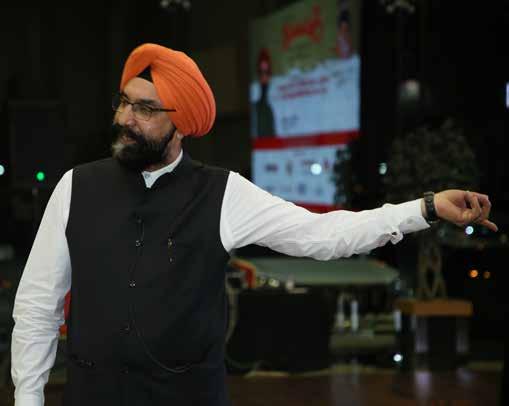
10 minute read
LIFESTYLE
T.S. Srinivas
Senior IT Specialist BAPCO
Advertisement
work and home life under the same roof?” “Will we be able to maintain our relationships and networks without our typical face-to-face connections?” and “How will managers support and engage fully remote teams?”
The authors of the study recently
In my entire career in Information Technology (IT) covering stints in India, USA and Bahrain - I had not experienced Work From Home (WFH) earlier - in the truest sense of the expression. For many, WFH means the rigidity of office timings is diluted. But, “ since I am habitually an early riser, I was starting work at the same time or even earlier! With all the current technology, one tends to remain connected with colleagues throughout the work day. However, since I am basically a people’s person, I really missed interacting and conversing with them in person. When you physically leave the office, there is a logical end-of-day feeling but in a WFH setting, there is no such clean break. Again, due to my customary practice of not leaving anything pending for the next day, I found myself enthusiastically working longer hours. By its very nature a house is not designed to function like a workplace. So, for effective WFH one definitely needs to invest in setting up a suitable work corner. In my experience of WFH, though I successfully carried out my work, but, personally I prefer working from office. “ released some takeaways and observed that “as our days became fragmented... with more meetings and personal responsibilities to juggle, we leaned on flexibility. Working in pockets helped, but sometimes we found that job demands rushed in to fill spaces previously reserved for personal downtime.” They also also found that “some teams have been intentional about encouraging employees to use their vacation time to unplug and relax” and these teams had been more productive and happy.
SALAAM SOCIETY BCICAI gets new Board

The Bahrain Chapter of the Institure of Chartered Accountants of India (BCICAI) has elected its Executive Committee for 2020-2021 with CA Ajaykumar Chettuvetty heading the team as Chairperson. The team as seen here are (seated l-r) CA Riya Bhansali (Joint Secretary), CA Sharmila Gandhi (Secretary), CA Santosh TV (Vice-Chairperson), CA Ajaykumar C. (Chairperson), CA Clifford D’Souza (Treasurer) and CA Bharat Venkat (Joint Treasurer). Standing are Members CA Roanna Miranda, CA Vinit Maroo, CA Vivek Gupta, CA Gaurav Agarwal and CA Natasha G. The BCICAI is affiliated to Bahrain Accountants Association
ENTERTAINMENT
A popcorn parade to the bank
Streaming services are fighting for eyeballs in movie-mad India where the lockdown has closed theatres – and movie stars are helping themselves to a slice of the profits. By FAYZA REUBEN
When the Netflix series “Indian Matchmaking” hit the smart screens, the kind of hullabaloo this mildly amusing show caused, showed exactly why online platforms like Netflix Inc., Amazon Prime and Walt Disney Co.’s Disney+ Hotstar are chasing Indian content.
Amazon Prime unlocked the home box office with ‘ Gulabo Sitabo’, a Bollywood film starring Indian legend Amitabh Bachchan, which was supposed to draw millions to cinema halls this spring. Instead, the crowd-pleasing Hindi satire debuted on Amazon.com Inc.’s Prime streaming service as the coronavirus kept Indians home.
It is a well-known fact that India makes more films and sells more tickets than any other worldwide, making it one of the biggest potential prizes for streaming platforms owned by Netflix, Disney, and Amazon. Bollywood -- as India’s mainstream film industry is called -- has long been resistant to shifting online, reasoning that the emphasis on larger-than-life story narratives and song-and-dance routines would be better enjoyed on the big screen where the money was.
Unprecedented lure
Despite these reservations, India is emerging as the world’s second largest marketplace for programming. The international firms don’t offer much detail on the growth of subscriptions in India, but their challenge will be to hold onto new users once big cinema halls reopen. But the changes of the coronavirus era are offering digital operators an unprecedented chance to lure new subscribers. The streaming services have been raking in first rights to play films usually watched in the large movie theatres popular in this nation of avid movie-goers. Netflix says it has added six new Indian films that would otherwise have gone to cinemas, while Disney has at least seven such movies on tap.
The pandemic is provoking a boom for streaming platforms in most other countries as well. The spread of lockdowns has hastened a trend already underway as the biggest platforms spent billions to build up online film libraries to lure viewers from theatres. India’s lockdown and stay-at-home restrictions have been one of the world’s most severe, halting visits to restaurants and shopping malls and forcing citizens to turn to online entertainment.
So far, global platforms have committed to investing billions into building local content, while keeping India prices low to amass viewers.


Netflix’s Chief Executive Officer Reed Hastings said during a visit to the country in December that Netflix intends to spend 30 billion rupees ($400 million) over 2019 and 2020 to produce more local content. Disney is adding blockbusters to a platform that had in the past relied on cricket as its biggest draw, a sport followed with spiritual zeal by Indians but which has postponed games because of the coronavirus. Amazon now offers a library of hit Bollywood films, including some featuring popular stars such as Shah Rukh Khan, for subscribers to its Prime shopping service.
Geared for growth
While the online onslaught has widened, India’s cinema industry isn’t planning to start lowering its curtains for good. A survey by researcher Ormax Media showed 82% missed going to cinema theatres during the lockdown. It is widely believed that once the pandemic passes and theatres reopen fully, there will be a surge in cinema attendance bolstered by releases that chose to wait, rather than debuting on streaming platforms. Cinema operators themselves are expressing confidence that filmmakers will still prefer to debut on a big screen.
“We have got a lot of assurance from our producer friends that they all believe in the power of a theatrical exhibition,” Alok Tandon, chief executive officer of Indian theater operator INOX Leisure Ltd., told investors on a conference call last month.
Meanwhile, streaming services are taking a leaf out of the game plan of satellite channels – just like the boosted ratings by signing on stars like Salman Khan and Amitabh Bachchan as game show hosts, Hollywood is signing up stars like Akshay Kumar (Amazon Inc.’s Prime) for their streaming service productions. Netflix recruited stars Saif Ali Khan and Nawazuddin Siddiqui for its first ever original series ‘ Sacred Games’, while Amazon hired Abhishek Bachchan to headline its series ‘Breathe’.
Amazon hasn’t broken out its number of subscribers in India, though it has said that most subscribers in India get Prime for the streaming, not for free delivery or other benefits. The strategy appears to be working. Media Partners Asia predicts

it will have 17 million paying subscribers by the end of the year, second only to Disney DIS +1.2% Plus Hostar, which will have 18 million, thanks in part to its rights to air Indian cricket. Netflix is lagging at 5 million paying subscribers, making India one of only a handful of markets where it isn’t the biggest player.
Asian vibe
Since Prime launched in India, Amazon has released 16 original series, including musicals, romances and thrillers. ‘Inside Edge’, its drama about a cricket team, became the first Indian show to be nominated for a Best Drama award at the International Emmys. Last year, Netflix launched a lower-priced plan in India meant only for smartphones. It hopes the plan will compete with the less expensive services from Amazon and Disney, whose Disney+ Hotstar could reach 100 million subscribers in India by 2025, according to a report by the research consultancy Media Partners Asia.
“In India, the potential for growth is huge ... and it’s mostly underestimated,” says Akshay Kumar, known in the industry as a savvy businessman, admitting that it was his teenage son who prompted his deal with Amazon when he asked why he wasn’t working on a “digital” series. “The way Indian audiences have matured and content has evolved is huge, and I want to be a part of it.”
Big Tech is looking past the theaters at a target-rich environment more suited to their business models. India is home to 1.35 billion people, most of whom are under the age of 35, a demographic that is expected to increase the business for online video almost three-fold to $4 billion in five years, according to research consultancy Media Partners Asia. Netflix and Amazon started streaming there in 2016 and launched Indian original content in 2018 and 2017, respectively. The pair is already putting out 10% of India’s original productions, according to a report from consulting firm Omdia, spending more than $500 million on local content in the past two years with an equal amount expected this year.
“Amazon and Netflix have been in a localisation arms race for India,” says Tony Gunnarsson, one of the Omdia analysts behind the report. “Localisation is hugely important everywhere. It’s not just about having content in the local language with subtitles or dubbing. But in Asia, it’s even more important.”
So turn on your streaming service, get out the popcorn and get ready to bring the box office home.

EDITOR’S VIEW

It is one of the first rules of journalism – especially in these times of information overdrive – that fact-checking is even more important than style and grammar. And nowhere is it felt more deeply than in the publication of maps. Unless it is a story about ancient geography or an evolving war story, only brave editors usually use maps to illustrate a point because however official the source, some country will contest the borders! Of course, around the time of national celebrations like August 15, freehand illustrations of India’s map are used everywhere from street banners to t-shirts, but that’s not taken seriously.
Salaam Bahrain had earlier published an article about the shift in cartography standards in India. The availability of satellite street maps from Google and smart phone apps have put pressure on the governments of countries like India to decentralise map-making and make the process more transparent. An accurate, officially-approved map that is digitally available on the internet for anyone to click open and zoom in for the tiniest of details – that is the gold standard we should aim for.
Nothing has impacted map-making as much as modern technology. Satellites, drones and other modern tools now allow high-resolution cartography that is accurate to a hair’s breadth. And it is not just about national borders. For example, the Survey of India’s ongoing project to map land holdings across the country will help to set to enable clear demarcations of property for land records, and it could serve other practical purposes such as aiding the burgeoning multi-million dollar e-commerce and home delivery businesses.
The truth is that map-making is an evolving science. Independent India’s contours, for example were not fixed on August 15, 1947. The outline of the country as we know it today took quite some time to form, with princely states like Hyderabad and non-British colonies like Goa being annexed or amalgamated by and by. Within a year of casting off Britain’s imperial yoke, for example, we lost two northern chunks of mountainous territory to Pakistan, which ceded the north-western part in the 1960s to China, with which our Line of Actual Control along the Himalayas has never been converted to a mutually-agreed border, despite diplomatic efforts. There have been a few other inductions, too, such as Sikkim’s in 1975. Also, a few minor handovers, like the Kabaw Valley that we gave to Myanmar as a friendly gesture in 1953 and Katchatheevu island awarded to Sri Lanka in 1974 under a maritime deal. The 2004 tsunami swallowed India’s southernmost Indira Point beyond the Andaman and Nicobar Islands.
All of which goes to show that we should not be hung up over our maps. But that is easier said than done. In the real world, because nation-states call the shots in global affairs, borders will not only remain relevant, they need to be defended from the incursive aims of aggressive countries. Borders are powerful markers of relations with neighbours, especially if a brute force on the other side sees their redefinition at its own whim as a way of asserting its dominance.
This Independence Day, let us celebrate the beloved contours of our India and remember that our commitment is to the idea of India and not just its physical boundaries.





